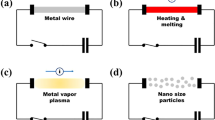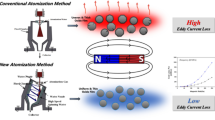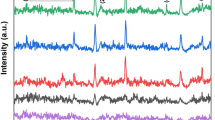Abstract
Soft magnetic film with high saturation magnetization (Ms) and low coercivity (Hc) is a critical class of material for RF inductors, which can enhance the inductance when inserted into film inductor. In this study, a series of micron-scale FeNix film are prepared via an electroplating process. The phase and element composition of the as-prepared FeNix films are analyzed through the X-ray diffraction (XRD) and energy dispersive spectroscopy (EDS), respectively. Results demonstrate that the iron nickel ratio of FeNix films can be adjusted by controlling the current density. The higher current density caused high nickel content, which may controllably prepare a series of micro-scale FeNix film. Moreover, SEM images and AFM photograph show that the films have no obvious defects and have a small roughness. We also found that the micron-scale FeNix film (~ 2.5 μm) presents high saturation magnetization (Ms = 1289.0 emu/cm3) and low coercivity (Hc = 76.8 A/m), which is feasible for magnetic core of RF inductors. Also, the electroplating method that preparing micro-scale FeNix film with controllable elemental composition can provide a referential experience for other soft magnetic film.







Similar content being viewed by others
Data availability
The data that support the findings of this study are available on request from the corresponding author.
References
L.Y. Gao, Z.Q. Liu, Electroplating low coercivity nanocrystalline Fe-Ni magnetic cores for high performance on-chip microinductor. LEEE Trans. Magn. 58, 1–7 (2022)
Y.H. He, Z.P. Zhang, R.X. Wu, W. Guo, H.W. Zhang, F.M. Bai, On-chip coupled inductors with a novel spliced anisotropic and isotropic magnetic core for inductance and coupling enhancement. Solid State Electron. 164, 107699 (2020)
H. Wu, M. Khdour, P. Apsangi, H.B. Yu, High-frequency magnetic thin-film inductor integrated on flexible organic substrates. LEEE Trans. Magn. 53, 1–7 (2017)
H. Liang, L. Zhang, H. Wu, Exploration of twin-modified grain boundary engineering in metallic copper predominated electromagnetic wave absorber. Small 18, e2203620 (2022)
H. Liang, H. Xing, M. Qin, H. Wu, Bamboo-like short carbon fibers@Fe3O4@phenolic resin and honeycomb-like short carbon fibers@Fe3O4@FeO composites as high-performance electromagnetic wave absorbing materials. Compos Part A 135, 105959 (2020)
A. Ammouri, H. Belloumi, T. Ben Salah, F. Kourda, Experimental Analysis of Planar Spiral Inductors. In: 2014 International Conference on Electrical Sciences and Technologies in Maghreb (Cistem). 1–5 (2014)
Q.R. Xiao, T.X. Luo, Y.L. Shi, D.W. Chen, H.B. Ye, S.J. Hu, Z. Ren, Simple and Accurate Radio Frequency Inductance Expression for On-chip Planar Spiral Inductors. Isape 2008: In: The 8th International Symposium on Antennas, Propagation and Em Theory, Proceedings, Vols 1–3. 1025–1028 (2008)
J.M. Lopez-Villegas, N. Vidal, J.A. del Alamo, Optimized toroidal inductors versus planar spiral inductors in multilayered technologies. LEEE Trans. Microw Theory. 65, 423–431 (2017)
V. Korenivski, GHz magnetic film inductors. J Magn Magn Mater. 215–216, 800–806 (2000)
C.R. Sullivan, Integrating Magnetics for on-Chip Power: Challenges and Opportunities. IEEE Cust. Integr. Cir. 15, 291–298 (2009)
N. Wang, T. O’Donnell, S. Roy, M. Brunet, P. McCloskey, S.C. O’Mathuna, High-frequency micro-machined power inductors. J Magn Magn Mater. 290–291, 1347–1350 (2005)
D. Mishra, P.M. Raj, R. Tummala, Design, fabrication and characterization of thin power inductors with multilayered ferromagnetic-polymer composite structures. Microelectron Eng. 160, 34–38 (2016)
W. Wang, Y. Chen, G.H. Yue, K. Sumiyama, T. Hihara, D.L. Peng, Magnetic softness and high-frequency characteristics of Fe65Co35-O alloy films. J. Appl. Phys. 106, 013912 (2009)
T. O’Donnell, N. Wang, S. Kulkarni, R. Meere, F.M.F. Rhen, S. Roy, S.C. O’Mathuna, Electrodeposited anisotropic NiFe 45/55 thin films for high-frequency micro-inductor applications. J. Magn .Magn. Mater. 322, 1690–1693 (2010)
D. Dinulovic, M. Kaiser, A. Gerfer, O. Opitz, M.C. Wurz, L. Rissing, Microtransformer with closed Fe-Co magnetic core for high frequency power applications. J. Appl. Phys. 115, 17a317 (2014)
G.Y. Zhou, W.H. Zhang, D. He, X.X. Li, S.X. Wang, Y. Hong, Y.M. Chen, C. Wang, W. He, H. Miao, J.Q. Zhou, A novel structured spiral planar embedded inductor: electroless-plating NiCoP alloy on copper coil as magnetic core. J. Magn. Magn. Mater. 489, 165363 (2019)
X.L. Xu, G.N. Feng, J.T. Liu, R.G. Zhu, X.Y. Yang, M.C. Liu, X.D. Xiong, X. He, J.F. Luo, C. Feng, G.H. Yu, Tailoring the magnetic properties of sputtered amorphous CoZrTa/metal-oxide (MO) by interfacial oxygen migration. J. Appl. Phys. 128, 165303 (2020)
P. Tiberto, N. Villar Alzola, A.V. Svalov, N.S. Mayura, N.A. Kulesh, A. Larrañaga, G.V. Kurlyandskaya, M. Affronte, F. Casoli, C. de Julián Fernández, G. Gubbiotti, C. Marquina, F. Pratt, M. Solzi, S. Tacchi, P. Vavassori, Structure and magnetic properties of FeNi/Ti sputtered multilayers. EPJ. Web Conf. 40, 17002 (2013)
T. Yanai, J. Kaji, K. Koda, K. Takashima, M. Nakano, H. Fukunaga, Magnetic properties of exchange-coupled Fe-Ni/Fe22Ni78 double-layered thick films. LEEE Trans. Magn. 54, 1–3 (2018)
M. Kumar, V.K. Verma, V.R. Singh, Magnetic anisotropic of thermally evaporated FeNi thin film: a soft X-ray magnetic circular dichroism study. Surf Interface Anal. 53, 808–813 (2021)
F.E. Rasmussen, J.T. Ravnkilde, P.T. Tang, O. Hansen, S. Bouwstra, Electroplating and characterization of cobalt–nickel–iron and nickel–iron for magnetic microsystems applications. Sensor Actuat A. 92, 242–248 (2001)
T. Shimokawa, T. Yanai, K. Takahashi, M. Nakano, K. Suzuki, H. Fukunaga, Soft magnetic properties of electrodeposited Fe-Ni films prepared in citric acid based bath. LEEE Trans. Magn. 48, 2907–2909 (2012)
N. Wang, T. O’Donnell, S. Roy, P. McCloskey, C. O’Mathuna, Micro-inductors integrated on silicon for power supply on chip. J. Magn. Magn. Mater. 316, E233–E237 (2007)
V. Pulijala, A. Syed, Comparison of the effects of 60 nm and 96 nm thick patterned permalloy thin films on the performance of on-chip spiral inductors. J. Magn. Magn. Mater. 419, 245–248 (2016)
D. Lan, H. Zhou, H. Wu, A polymer sponge with dual absorption of mechanical and electromagnetic energy. J, Colloid Interf. Sci. 633, 92–101 (2022)
S. Zhang, B. Cheng, Z. Jia, Z. Zhao, X. Jin, Z. Zhao, G. Wu, The art of framework construction: hollow-structured materials toward high-efficiency electromagnetic wave absorption. Adv. Compos. Hybrid Mater. 5, 1658–1698 (2022)
X. Wei, W. Chen, N. Liu, H. Fan, Dendritic FeNi3 phase grown on copper foil by electrodeposition as electrocatalyst for efficient oxygen evolution reaction. J. Alloys Compd. 830, 154708 (2020)
Acknowledgements
The authors are grateful to the Project of 9th Institute of China Electronics Technology Group Corporation (No. 2022SK-007), and the Funded by the Project of State Key Laboratory of Environment-friendly Energy Materials, Southwest University of Science and Technology (No. 20fksy23,21fksy27), and supported by Sichuan Science and Technology Plan (No. 2021YFG0223).
Funding
The authors have not disclosed any funding.
Author information
Authors and Affiliations
Contributions
ST: Conceptualization, Methodology, Formal analysis, Resources, Data Curation, Writing—Original Draft. QN: Investigation, Formal analysis. HC: Investigation. JL: Investigation. YZ: Investigation. BD: Supervision. FX: Formal analysis, Writing—Review & Editing. JL: Funding acquisition. YR: Resources, Supervision, Writing—Review & Editing.
Corresponding author
Ethics declarations
Conflict of interest
All co-authors agreed to this submission, which has not been considered by any other journal.
Ethical standards
The full paper has not been submitted or published elsewhere and will not be submitted elsewhere until the journal editorial process is complete.
Additional information
Publisher's Note
Springer Nature remains neutral with regard to jurisdictional claims in published maps and institutional affiliations.
Rights and permissions
Springer Nature or its licensor (e.g. a society or other partner) holds exclusive rights to this article under a publishing agreement with the author(s) or other rightsholder(s); author self-archiving of the accepted manuscript version of this article is solely governed by the terms of such publishing agreement and applicable law.
About this article
Cite this article
Tang, S., Nie, Q., Chen, H. et al. The influences of current density on chemical composition and magnetic properties of FeNix film prepared by electrodeposition. J Mater Sci: Mater Electron 34, 530 (2023). https://doi.org/10.1007/s10854-023-09888-5
Received:
Accepted:
Published:
DOI: https://doi.org/10.1007/s10854-023-09888-5




